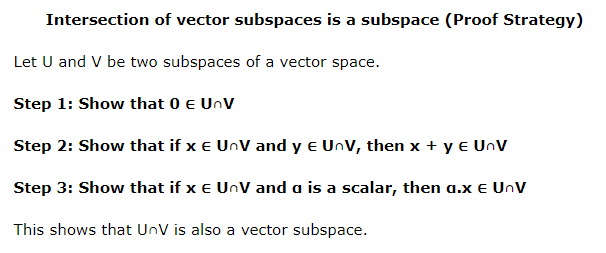In this article, we give a step by step proof of the fact that the intersection of two vector subspaces is also a subspace.
The proof is given in three steps which are the following:
- The zero vector lies in the intersection of the subspaces.
- The intersection is closed under the addition of vectors.
- The intersection is closed under multiplication by scalars.
Proof:
Let W be a vector space and U and V be two subspaces of the vector space. Then, U∩V is also a vector subspace.
Step 1: Show that 0 ∈ U∩V
Since U itself is a vector space it contains the zero vector, which is
0 ∈ U (EQUATION 1)
Similarly, since V is also a vector space we get,
0 ∈ V (EQUATION 2)
Combining (EQUATION 1) and (EQUATION 2) we see that,
0 ∈ U∩V
This proves that the intersection contains the zero vector and is non-empty.
Step 2: Show that if x ∈ U∩V and y ∈ U∩V, then x + y ∈ U∩V
Since x ∈ U∩V, this implies that x ∈ U. Similarly y ∈ U∩V, this implies that y ∈ U. Now, since U is a vector space it is closed under vector addition.
x ∈ U and y ∈ U ⇒ x + y ∈ U (EQUATION 3)
Similarly, since V is closed under vector addition we get,
x + y ∈ V (EQUATION 4)
Combining (EQUATION 3) and (EQUATION 4) we conclude that,
x + y ∈ U∩V
This proves that U∩V is closed under vector additon.
Step 3: Show that if x ∈ U∩V and α is a scalar, then α.x ∈ U∩V
Since x ∈ U∩V, this implies that x ∈ U. Since U is a vector space it is closed under scalar multiplication. This means that,
α.x ∈ U (EQUATION 5)
Similarly, x also belongs to the vector space V which is also closed under scalar multiplication. We have,
α.x ∈ V (EQUATION 6)
Combining (EQUATION 5) and (EQUATION 6) we get,
α.x ∈ U∩V
This proves that U∩V is closed under scalar multiplication.
The above three steps complete the proof of the theorem. We summarize the proof strategy in the image below.
